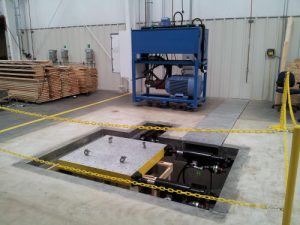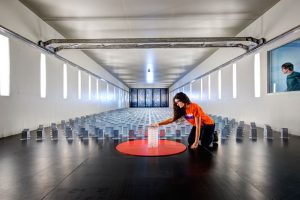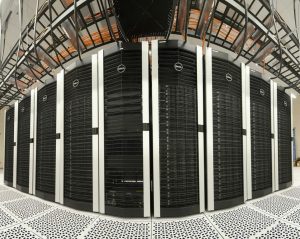Experimental Resources
Powell Family Structures & Materials Laboratory at Engineering School Of Sustainable Infrastructure & Environment
 6-DOF Shake Table: A 4 ft x 4 ft, six degree-of-freedom shake table with a one-ton payload and ≈ 6 inches of stroke in each of the x-, y-, and z-directions. The complex motion generation capabilities of the shake table will enable testing and monitoring of the structural response of scale models and components in a controlled environment.
6-DOF Shake Table: A 4 ft x 4 ft, six degree-of-freedom shake table with a one-ton payload and ≈ 6 inches of stroke in each of the x-, y-, and z-directions. The complex motion generation capabilities of the shake table will enable testing and monitoring of the structural response of scale models and components in a controlled environment.
The lab has an 80’ x 32’ strong floor that is 4’ thick and has mounting plates 4’ on center. This allows large loads to be anchored into place using the anchor points with a 200kip capacity. The lab is equipped with a 2000-square-foot machine shop with metal and wood working capabilities. This shop is outfitted with sufficient 110/220V electrical outlets and a centralized pneumatic air system. The lab also contains a central tool rack to store all portable tools.
Acknowledgment to the previous PI Dr. Jennifer Bridge.
UF NHERI Experimental Facility Boundary Layer Wind Tunnel

The University of Florida (UF) NHERI Experimental Facility (EF) provides users access to one of the largest and most diverse suite of wind engineering experimental research infrastructure in the world. The Boundary Layer Wind Tunnel (BLWT) is a 6 m wide, 3 m tall and 40 m long wind tunnel designed to simulate boundary layer flows to characterize the wind loading and structural behavior, including aeroelastic response of wind-sensitive structures (Figure 1). Unique aspects of this facility are its large size and automated continuously adjustable terrain roughness field (the “Terraformer”). Eight 1.5 m diameter, 75 HP motor driven Aerovent vaneaxial fans can generate speeds of up to 18 m/s while maintaining +/ 1 fan RPM. The Terraformer consists of a 6 m x 18 m field of 1,116 individually controlled 100 mm long x 50 mm wide cuboid elements which raise out of the tunnel floor up to 160 mm each, to form a heterogeneous or homogeneous terrain field. Reconfiguration of the terrain field takes approximately 2 minutes, allowing for rapid testing of multiple terrain configurations. Models are mounted on a 1-meter (current) or 4-meter (future upgrade) diameter turntable for 360° exposure to wind direction.
More information can be found Here.
Computational Resources

The University of Florida supercomputer is a cluster that includes the latest generation of processors and offers nodes for memory-intensive computation. HiPerGator’s high-performance storage systems can be accessed from diverse interfaces, including Globus, UFApps for Research, and other tools. The PIs will have allocations of 100 CPUs and 5 GPUs.
The desktop computers at the labs each have a 50 TB data storage drive for temporary storage and local use. Additional storage capacity of 30 TB is procured from the HiPerGator for big data storage that will be utilized to store the data during the performance period of the project, and preserve them after the completion of the project. In partnership with UFIT’s Infrastructure and Communication Technology Services (ICT), UFIT’s Research Computing department established the Campus Research Network (CRN) as a high-bandwidth, low-latency Ethernet network linking major research labs and data centers within the University. The CRN is separate from the main campus network, dedicated to the movement of research data, and serves as a research DMZ.